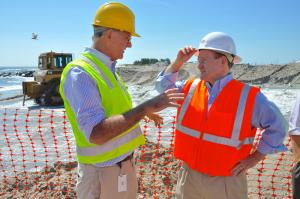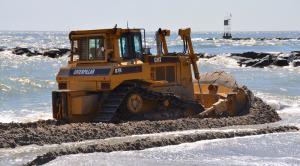Officials take tour of inlet dredge site
Gov. Jack Markell and U.S. Sen. Chris Coons got a first-hand look at the beach replenishment job designed to protect the $150 million Indian River Inlet bridge.
When the state's highest elected officials make plans to visit, others usually follow. Markell and Coons were accompanied on the beach early Aug. 5 by Sussex County legislators and U.S. Army Corps of Engineers, Department of Transportation and Department of Natural Resources and Environmental Control officials.
Contractor Manson Construction of Jacksonville, Fla., started pumping sand last week after winning a $6.6 million contract from the U.S. Army Corps of Engineers funded by Hurricane Sandy relief money. Replenishment has also started in Fenwick Island; beach rebuilding will continue along the coast for the next five months.
Hurricane Sandy eroded the beach on the north side of the inlet, sending sand and water over Route 1 and closing the Indian River Inlet bridge for almost a week.
Over the next month, workers will pump 520,000 cubic yards of sand from the bottom of the Indian River Inlet to rebuild a 3,500-foot section of beach – about two-thirds of a mile of coastline, said Tony Pratt, administrator of DNREC's Shoreline and Waterways Management Section. It was Pratt who led the tour of the dredge site near the north-side jetty.
Officials touted the importance of the state's beaches. “We can't control Mother Nature, but we can do everything we can to protect and defend,” Pratt said.
“The protection in place is so important,” Markell said. “It's important to get this done; I'm encouraged to see the progress.”
There were plenty of accolades to go around. “We are celebrating the hard work our congressional delegation has done,” Markell said as Coons joined the delegation.
Markell also had praise for Pratt's leadership. “He is one of the great guys in the country,” Markell said. “He understands how to make this happen.”
Two benefits to dredging project
Pratt said the dredging and replenishment project has two benefits: the beach being rebuilt and the inlet channel will be deepened aid navigation. In addition, Pratt said, the replenishment project will benefit from about 100,000 cubic yards of sand moved across the bridge via the sand- bypass system. Sand is pumped from the south-side beach to the sand-starved north-side beach. A jetty along the inlet blocks sand from its normal south-to-north migration along the coast.
Within two to three weeks, another Army Corps subcontractor will begin a project to repair a 300-foot section of the north-side jetty, Pratt said. “It is a weak area,” he said. “It will be taken care of so that sand doesn’t leak back though it.”
Work to widen the beach and build up the dune will take place 24 hours a day in 1,000-foot sections of beach. Sections where pumping is taking place will be closed, said Army Corps spokesman Steve Rochette said.
Rochette said the new beach will have a 25-foot wide dune that will be 16 feet above sea level, which is similar to other dunes along the Delaware coast. He said the contract states the beach must be a minimum of 50 feet wide, but most of the beach will be much wider. Work is expected to be completed by early to mid-September.
Replenishment projects in Fenwick Island, South Bethany, Bethany Beach, Dewey Beach , Rehoboth Beach and Lewes are also scheduled to take place over the next five months; each project should take about 25 to 30 days to complete. Work has begin in Fenwick Island.
Contractor Great Lakes Dredge and Dock Co. will move north, stopping at each coastal town after completing work in Fenwick Island. Rochette said the total cost of the projects is $19.3 million with 1.3 million cubic yards of sand to be pumped on the beaches. Work in Dewey and Rehoboth should take place in the fall; work in Lewes is expected to begin in September.
A cubic yard of sand
How much is a cubic yard of sand? A dump truck holds 10 to 12 cubic yards of sand. The Indian River Inlet beach project would require about 52,000 dump-truck loads of sand.



























































